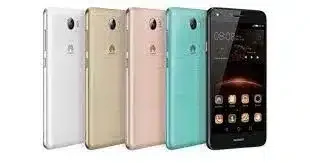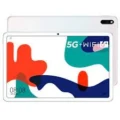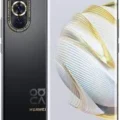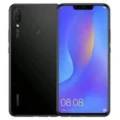Huawei Y3 (2018)





- : 1GB RAM MT6737M
- : 5.0" 480x854 pixels
- : 2280mAh
- : 8MP 720p
Stay Connected & Capture Basic Moments: Huawei Y3 (2018)
- Connect with ease: Huawei Y3 (2018) Make calls, send texts, and use essential apps to stay in touch with loved ones, all at a budget-friendly price.
- Capture life’s moments: Take basic photos with the rear camera, suitable for capturing memories and sharing on social media.
- Enjoy entertainment on the go: Browse the web, watch videos, and play light games on the display.
- Long-lasting battery: Stay connected throughout your day without worrying about running out of power.
Important considerations:
- Limited features: This phone prioritizes affordability and essential functionalities. Consider your needs if you require advanced features like high-resolution cameras or extensive storage.
- Released in 2018: Technology advances quickly, so newer models might offer improved performance, camera quality, and software updates.
- No Google Mobile Services (GMS): This phone doesn’t come pre-installed with apps like Gmail, YouTube, and Maps. Alternative apps exist, but explore those options if these are essential for you.
The Huawei Y3 (2018) offers basic functionalities at an attractive price, making it a good choice for users on a budget. Remember to explore alternative apps if you rely heavily on Google services and consider newer models for the latest technology and potentially better performance.
Want to Learn More?
Visit the official website of Huawei for detailed information about the Huawei Y3 (2018): Huawei Official Website
Still Unsure?
If you’re still unsure about your choice, explore other options from Huawei at your nearest store: Huawei Store
Specs
Network
| 2G Network GSM 850 / 900 / 1800 / 1900 - SIM 1 & SIM 2 (dual-SIM) CDMA 800 / 1900 |
GSM 850 / 900 / 1800 / 1900 - SIM 1 & SIM 2 (dual-SIM model only) |
| 3G Network | HSDPA 850 / 900 / 1900 / 2100 |
| 4G Network | 1, 3, 7, 8, 20 |
| Speed | HSPA, LTE |
LAUNCH
| Announced | May, 2025 |
| Status | Available. Released 2018, May |
BODY
| Dimensions | 145.1 x 73.7 x 9.5 mm (5.71 x 2.90 x 0.37 in) |
| Weight | 175 g (6.17 oz) |
| Build | Glass front, plastic back, plastic frame |
| SIMs SIM (Subscriber Identity Module) is a small card that contains mobile network subscriber's account information. This allows the phone using the card to attach to a mobile network. The SIM card is most commonly associated with GSM and UMTS mobile networks. Moving a SIM card from one phone to another allows a subscriber to switch mobile phones without having to contact their mobile network carrier. SIM cards can also be used by a phone to store limited amounts of data, such as phone numbers and text messages. | Single SIM (Micro-SIM) or Dual SIM (Micro-SIM, dual stand-by) |
Display
| Display Type Display Technology => A number of display technologies and types used in mobile phones => TFT (Thin Film Transistor), IPS (In-Place Switching), OLED (Organic Light Emitting Diode), AMOLED (Active-Matrix Organic Light-Emitting Diode), Super AMOLED (an even advanced version of AMOLED), Resistive Touchscreen (Resistive touchscreens contain two layer of conductive material with a very small gap between them which acts as a resistance), Capacitive Touchsceen (Capacitive touchscreen technology consists of a layer of glass coated with a transparent conductor) | IPS LCD |
| Size | 5.0 inches, 68.9 cm2 (~64.4% screen-to-body ratio) |
| Resolution | 480 x 854 pixels, 16:9 ratio (~196 ppi density) |
PLATFORM
| Operating System OS => Every computer system run on a base software called Operating System (OS). Operating System controls all basic operations of the computer (such as smartphone, PDAs, tablet computers and other handheld devices). The Operating System allows the user to install and run third party applications (apps), apps are used to add new functionality to the device. | Android 8.0 Oreo (Go edition) |
| Chipset Chipset is a group of integrated circuits designed to perform one or a more dedicated functions, often with real time computing constraints, Popular smartphones are equipped with more advanced embedded chipsets that can do many different tasks depending on their programming. | Mediatek MT6737M (28 nm) |
| CPU CPU (Central Processing Unit) mostly known as processors, CPU processes instructions in order to carry out certain functions that make your device operate properly. Processors are often described as the brain of computers, smartphones and tablets, Smartphones and tablets rely on processors to carry out their every task, Processors are an incredibly important factor in selecting any type of computing device, including your smartphone. | Quad-core 1.1 GHz Cortex-A53 |
| GPU GPU (Graphics Processing Unit) is a single-chip processor designed to rapidly manipulate and alter memory to accelerate the creation of images in a frame buffer intended for output to a display, This includes things such as lighting effects, object transformations, and 3D motion. | Mali-T720MP2 |
MEMORY
| Card Slot Memory Card Slot is a special slot for inserting a memory card. Memory cards allow you to expand the phone's built-in memory, A memory card (sometimes called a flash memory card or a storage card) is a small storage medium used to store data such as text, pictures, audio, and video, for use on small, portable or remote computing devices such as mobile phones, mp3 players, digital cameras. | microSDXC (dedicated slot) |
| Internal | 8GB 1GB RAM eMMC 5.0 |
MAIN CAMERA
| Cameras Specs Today’s smartphones come equipped with a very comprehensive set of camera related specifications. Our smartphone, for many of us, has become our primary camera due to it being the one we always have with us. |
8 MP, f/2.0, AF |
| Video | 720p@30fps |
| Camera Features |
LED flash |
SELFIE CAMERA
| Cameras Specs Today’s smartphones come equipped with a very comprehensive set of camera related specifications. Our smartphone, for many of us, has become our primary camera due to it being the one we always have with us. |
2 MP |
SOUND
| Loudspeaker | Yes |
| 3.5mm jack | Yes |
COMMS
| WLAN |
Wi-Fi 802.11 b/g/n |
| Positioning | GPS |
| Bluetooth Bluetooth is a wireless communications technology for exchanging data between mobile phones, headsets, computers and other network devices over short distances without wires, Bluetooth technology was primarily designed to support simple wireless networking of personal consumer devices. | 4.0, A2DP |
| Infrared Infrared connectivity is an old wireless technology used to connect two electronic devices. It uses a beam of infrared light to transmit information and so requires direct line of sight and operates only at close range. | |
| USB | microUSB 2.0 |
| NFC NFC (Near field communication) is a set of standards for smartphones and similar devices to establish peer-to-peer radio communications with each other by touching them together or bringing them into proximity, usually no more than a few inches. | |
| Radio |
Features
| Sensors Sensors are electronic components that detects and responds to some type of input from the physical environment. The specific input could be light, heat, motion, moisture, pressure and location, The output is generally a signal that is converted to use in computing systems, a location sensor, such as a GPS receiver is able to detect current location of your electronic device. |
Accelerometer, proximity |
BATTERY
| Battery Type Battery Type => Cell phones run on various kinds of batteries depending on the manufacturer, phone size or shape and features. There are basically four types of cell phone batteries => Lithium Polymer, Lithium Ion, Nickel Metal Hydride and Nickel Cadmium. | Li-Ion (Lithium Ion) |
MISC
| Colors |
Gold, White, Gray |
| Model | CAG-L02, CAG-L22, CAG-L23, CAG-L03 |
| Price | About 90 EUR |
TESTS
Reviews
Disclaimer Note
We strive to maintain accurate and up-to-date content on our website for general information purposes only. Please refrain from using the material for business, legal, or any other decisions.



















